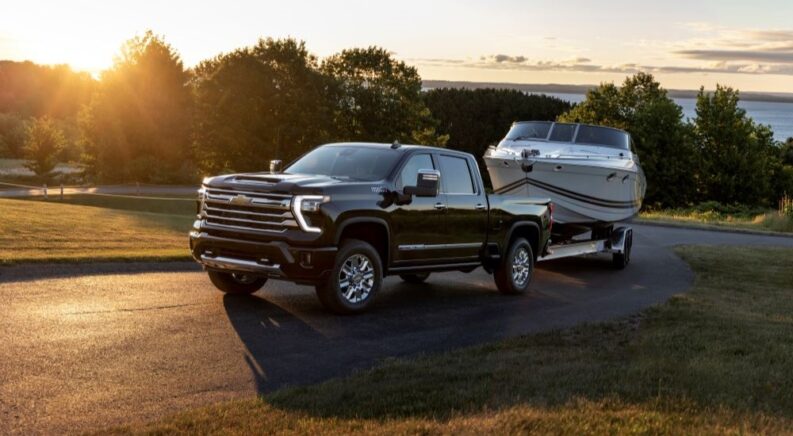If you’re looking for top-tier towing performance, it’s hard to do better than a heavy-duty pickup like the 2024 Chevy Silverado 2500 HD. New and improved for 2024, this heavy-duty version of Chevy’s full-size pickup is a true towing beast. The automaker has upgraded almost every aspect of the Silverado 2500 HD, overhauling the engine, transmission, and interior while packing the pickup with the latest and greatest in towing technology.
It all starts under the hood. Chevy’s retained the same engine lineup found on previous models—a 6.6L V8 gas engine and a 6.6L V8 Duramax diesel—but made some important changes that allowed drivers to squeeze more power out of the existing powertrains. The diesel has been tweaked to improve performance, with Chevy’s engineers updating the pickup’s control architecture, combustion system, and turbocharger. The result? They’ve managed to up horsepower from 445 to 470 while simultaneously improving torque from 910 lb-ft to an impressive 975.
The other major upgrade for 2024 comes in the form of a ten-speed automatic Allison gearbox, which replaces the six-speed automatic found on previous models. The new gearbox allows the Silverado 2500 HD to better harness its peak power, which is something you’ll be thankful for next time you’re trying to get your fully loaded truck up to highway cruising speed. The updated engine and Allison gearbox give the 2024 Silverado 2500 HD a max tow rating of 22,500 lbs and a Gross Combined Weight Rating of 26,000 lbs, placing the pickup near the top of its category in terms of sheer power.
While power is a boon to any towing task, it’s only half the battle. Chevy has outfitted the 2024 Silverado 2500 HD with the latest in towing and hauling technology, from an adaptive cruise control system, which accounts for the additional drag and increased braking distances that occur while towing, to its Transparent Trailer View, a rear-facing camera that effectively makes large trailers and campers see-through, allowing drivers to monitor the road behind them without having their view obstructed. The pickup also includes a shot of towing-focused safety technology like Trailer Side Blind Zone Alert, which monitors the extended blind zone created by trailers, to a GCW Alert, which lets drivers know when they’ve exceeded the Silverado’s Gross Combined Weight Rating.
While it’s hard to go wrong when it comes to putting your Silverado 2500 HD to work, even the most well-outfitted truck on the market needs an experienced operator behind the wheel. Chevy has loaded the 2024 Silverado 2500 HD with some of the best towing-related tech on the market, but the pickup still can’t drive itself (for now). Before you climb into the cab of Chevy’s latest heavy-duty offering, take a few minutes to read over this basic guide to towing and hauling. Packed with tips, tricks, and a general overview of the towing process, this quick refresher will help to ensure that you’re able to squeeze every last ounce of towing performance out of your new Silverado 2500 HD.
Towing Terms
The first step to any successful towing venture is making sure you and your truck are speaking the same language. From towing and payload capacity to GCWR, GVWR, and more, there can be a lot of jargon to cut through when it comes to towing. Here’s a quick overview of some of the basic terms you’re likely to come across when you tackle your next towing job.
Payload Capacity: While some less experienced drivers might use the terms interchangeably, towing and payload capacity are very different in real-world terms. Payload capacity refers to how much weight a vehicle can between the bed and cabin combined, as well as the tongue weight from any trailer you might be towing. A vehicle’s payload capacity is often less than you might think, but the figure includes everything in the vehicle, including the driver and passengers. Take a Silverado 2500 HD Regular Cab with 2WD, for example. The truck has a listed payload capacity of 3,759 lbs, but once you subtract the weight of two 160 lb passengers, you’re left with an actual payload capacity closer to 3,400.
Towing Capacity: Towing capacity is a little more straightforward than payload capacity and just refers to the amount of weight a vehicle can tow behind it on a trailer. Towing capacity isn’t affected by the weight of the driver, passenger, or anything else in the vehicle itself, just the weight of the items placed in the trailer. When equipped in its brawniest guise, the Silverado 2500 HD has a towing capacity of 22,500 lbs. As is often the case, this number is much larger than the truck’s payload capacity, and with good reason; consider how much easier it is for you to pull a heavy load piled in a cart than it is to carry the same load on your shoulders.
Gross Vehicle Weight Rating (GVWR): This describes a vehicle’s maximum loaded weight capacity. This number takes into account not just the weight of the passengers and cargo but the vehicle itself. This can be a misleading metric as a heavier vehicle is naturally going to have a higher GVWR, so it’s not terribly useful when it comes to towing and hauling applications. Still, it’s a good term to be familiar with, though it’s mostly just relevant when it comes to determining how much of a load a vehicle’s suspension, frame, and axles can bear. The GVWR of the 2024 Silverado 2500 HD remains largely unchanged since the 2023 model, ranging from 10,000 lbs for the 2WD Regular Cab model to 11,350 lbs for the 4WD Crew Cab version.
Gross Combined Weight Rating (GCWR): This is basically a version of GVWR that takes a trailer’s weight into account. The passengers, trailer, vehicle, and any cargo spread across the vehicle and the trailer all factor into a vehicle’s GCWR. The GCWR for the 2024 Chevy Silverado 2500 HD is among the best in its class, ringing in at 26,000 lbs. Given that the average RV (recreational vehicle) weighs around 10,000 lbs, the Silverado’s impressive GCWR ensures that you’ll be able to bring all the comforts of home on your next weekend excursion.
Gross Trailer Weight (GTW): This is the total weight of the trailer itself, along with any cargo it might be holding. It’s not a limit that describes how much weight a trailer can safely hold but rather a descriptive measurement that’s useful when you’re doing your pre-towing weight calculations. GTW can range from as low as 1,700 lbs for a small teardrop camper to 2,800 lbs for a small travel trailer and all the way up to 12,700 lbs for a large fifth wheel camper.
Tongue Weight: Tongue weight describes the amount of downward force that’s placed on the back of a vehicle by a towed trailer. When calculating a vehicle’s towing capacity, the overall weight of the trailer (its GTW) is often actually less important than the tongue weight due to the fact that the trailer itself is sharing some portion of the load. While the trailer’s GTW is going to remain constant no matter how the cargo is distributed, the tongue weight can be easily modified by moving heavier items forward or backward on the trailer itself. While not as well-known as some of the other terms on the list, tongue weight can be a vital factor when it comes to safe and effective towing.
Loading a Trailer
All the in-vehicle towing technology in the world doesn’t mean a thing if you’re dealing with a trailer that hasn’t been properly loaded. The way weight is distributed across a trailer can be the difference between a successful towing job and one that ends in disaster, as evidenced in this handy video. When loading up a trailer, make sure the weight is evenly distributed—not just to the front and back, but to the left and right sides as well. As a general rule of thumb, it’s a good idea to load heavier items towards the front of the trailer, taking care to make sure they’re placed in front of the trailer axle. Most experts recommend that 60% of the overall cargo weight be placed towards the front of the trailer to minimize fishtailing and other dangerous effects of an unbalanced load. That said, you’ll want to keep your eye on the tongue weight throughout the process.
As a general rule of thumb, you’ll want to ensure that the weight exerted on the tongue is between 10% and 15% of the trailer’s overall GTW. If the number starts to creep north of that 15% mark, reshuffle items and move weightier cargo to the back. Likewise, it’s important to ensure the tongue weight doesn’t fall below 10%, as it can have similarly dangerous effects on overall driving safety. Once everything is loaded and balanced, it’s time to batten down the hatches; after you’ve ensured your trailer’s spare tire is in good condition and fastened down, grab some straps and start to secure the load from multiple angles. As you accelerate, decelerate, and take tight turns, a trailer load is liable to shift in all directions, so it’s important to keep this in mind before you hit the road.
At this point, you might be asking yourself: How am I supposed to determine the tongue weight? Most towing supply stores will offer a specially built, high-capacity tongue weight scale that can easily spit out a figure, and some newer trailers even come with a built-in tongue weight scale. If those options aren’t available, there’s a [relatively] simple DIY method that works just as well. Grab a bathroom scale and a brick of the same height and place them three feet apart, then place two support pipes on the brick and one on the center of the scale before laying a 2×4 wood beam across all three pipes. This assembly should be in such a position that the trailer tongue is inside that three-foot span between the scale and the brick: one foot from the center of the brick and two feet from the center of the scale. Then, lower your trailer’s tongue until the full weight of the trailer is resting on the assembly—atop the 2×4 wood beam and no longer propped up elsewhere. Take the weight displayed on the scale, multiply it by three, and you’ve got your trailer’s total tongue weight. While this is not the easiest approach, it’ll get the job done if you don’t have time to find a true tongue weight scale nearby.
The New Silverado 2500 HD
Heavy-duty trucks are the true workhorse of the pickup world, built for towing and designed to get the job done with minimal fuss. We know that terms like GVWR, GTW, tongue weight, and towing capacity can be a lot to take in, but once you wrap your head around these terms and concepts, it will unlock a whole new world of possibilities. In fact, with a little know-how and practice, the 2024 Chevy Silverado 2500 HD can tackle almost any towing job you can throw at it, from hauling the family RV or boat to towing other vehicles, horses, heavy equipment, and more.
Raw power is one thing, but the Silverado 2500 HD is a well-rounded pickup that leverages some of the industry’s most cutting-edge tech to deliver a seamless and stress-free towing experience. With the 2024 Silverado 2500 HD, Chevy is making hard work easier than ever, giving every driver the opportunity to take advantage of the pickup’s legendary reputation for performance under pressure.






